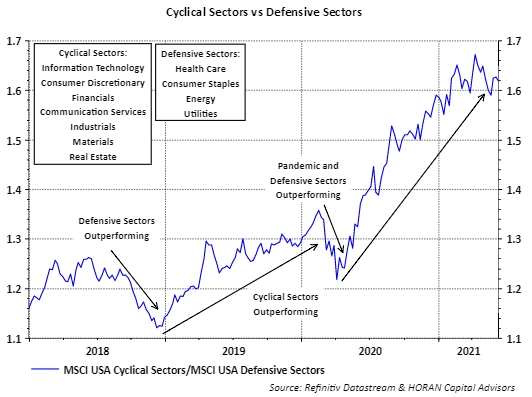Investing in Defensive Sectors


- Defensive sectors (healthcare, staples, utilities, plus some telecom/defense) provide steadier demand and cash flows, cushioning portfolios in downturns.
- Their resilience stems from essential, inelastic consumption and regulated revenues, resulting in smaller drawdowns and better risk-adjusted returns over time.
- Growth drivers include ageing populations, product innovation, emerging-market demand, and utility transition to clean energy, despite regulatory and rate sensitivities.
- Portfolio approach: hold a diversified sleeve via leaders or ETFs, mind valuations and opportunity costs in bull markets, and size exposure to align with risk tolerance and horizon.
Shelter in Market Storms
TradingKey - Markets don't travel in autobahn-like straights. Optimistic and growth periods always yield to declines, corrections, and occasionally crises. Among the investor protections against volatility’s extremes are defensive sectors, which are business sectors whose demand remains relatively stable across business cycles. These are sectors of health care, consumer staples and utilities with a few telecom and defense names. Although they aren't always sites with rapid returns, they serve as portfolio ballast, keeping the capital intact as the markets become rough.
Defensive investing is neither risk aversion nor risk avoidance; it’s risk management. Dividing a portfolio into stable-earning and dividend-paying sectors helps investors derive resilience. Several decades of evidence confirm that balanced portfolios with defensive exposure recover from declines more rapidly and experience less drawdown. In a world of greater uncertainty, from inflation and interest-rate increases to geopolitical shocks, defensives are as relevant as they've ever been.
Why Defensive Industries Matter
Defensive sectors are characterized by elastic demand. One needs electricity, groceries, medical facilities, and telecommunications facilities, irrespective of whether the GDP is increasing at a rate of 5% or decreasing. It results in stable demand and, consequently, stable and predictable cash flows for companies, which in turn support sustainability and dividend payments.
Healthcare offers insulation through drugs, medical equipment, and health services that are immune to recessions. Consumer staples sell products that individuals purchase irrespective of changes in income, such as beverages, foods, and personal care products. Utilities, therefore, are involved with regulated sectors where revenues are cushioned from business fluctuations.
This resilience comes into play during bear markets. Growth stocks may decline by 50% or more during corrections, while defensive names experience more shallow drops. Laggards during bull markets, over the entire cycle, their braking power enhances risk-adjusted returns.

Source: https://www.horanwealth.com
Key Growth Drivers
Although frequently considered dull sectors, defensive sectors are anything but stagnant; healthcare, for instance, benefits from demographic tailwinds, such as ageing populations and increasing global demand for caregiving. Growth layers are added through innovation in biotechnology, gene therapy, and medical devices.
Consumer staples adapt to shifts in consumer tastes. Health foods, environmentally friendly packaging, and growth from emerging markets create growth in developed sectors. Multinational companies such as Nestlé and Procter & Gamble continue localizing their products to global taste.
-5da613ff2f1f4781a597ff36e70ba401.jpg)
Source: https://www.guinnessgi.com
Utilities are being reshaped as a result of the shift to clean energy. Old-line regulated electrical utilities are making heavy investments in renewable energy sources, battery storage, and grid upgrades. This diversifies revenue streams, apart from aligning with policy pushes that fuel capital inflows. Defense contractors are as cyclical as a defensive stock with ties to government spending budgets. Increasing geopolitical tensions are a good backstop to spending increases.
-e7e52f82344f4baf9c159679d04c29df.jpg)
Source: https://www.pv-magazine-usa.com
Investment Prospects
In healthcare, giants like Pfizer and Johnson & Johnson offer stability with solid pipelines and dividends; device manufacturers such as Abbott Laboratories and Medtronic experience steady growth. For diversified exposure-seeking investors, health-care ETFs span drugs, biotech, and health-care services.
Consumer staples leaders include Procter & Gamble, Coca-Cola, and Nestlé. These have global dominance, price power, and consistent dividend growth. Discount stores, such as Walmart and Costco, also belong to this group and often enjoy consumer trade-downs during recessions.
Utilities are also represented through regulated electric providers, such as NextEra Energy, Duke Energy, and Dominion Energy. Being steady dividend and clean portfolio holders are their attractive defensive bets.
Telecoms such as Verizon and AT&T offer an additional measure of protection through recurring subscription revenue. As not wholly immune to competition, their part of vital connectivity helps with flexibility.
Defense companies such as Lockheed Martin and Northrop Grumman are supported by long-term government contracts. Although they are not always cookie-cutter “defensive” stocks, their revenues are significantly less cyclical than those of average industrials.
Risks and Challenges
Defensive doesn’t equal risk-free. Healthcare has regulatory pressures on drug reimbursement and price policies. Consumer staples are subject to margin pressures from input and changing consumer preferences. Utilities are capital-intensive and interest-rate sensitive, with dividends yielding against bond income.
Valuation risk also appears as a problem. Defensive stocks tend to sell at premiums during turbulent times, as speculators flock to safety. Purchasing defenses at high valuations may restrict upside once stabilization comes back into markets.
There’s also that complacency risk. Defensive sectors underperform during large bull markets, and that may bring opportunity costs for investors who are overtly positioned in them. Balancing of allocation helps prevent underperformance.
Portfolio Positioning
For general investors, defensive sectors should constitute a core allocation in diversified portfolios. The specific weight varies with risk tolerance and time horizon. Young investors might demand subtle defensive exposure with an emphasis towards growth. Near-retirees or conservative investors may rely more on defensive investments with the aim of preserving capital.
A diversified strategy involves a blend across utilities, staples, and healthcare, with a topping of telecoms and defense sectors as a form of diversification. ETFs afford cost-efficient access while individual stocks grant specific exposure to dividend aristocrats or innovation leaders. Dividends are a key attraction. Defensive stocks yield above-average returns and offer income flows that compound through retention. In an inflationary and volatile climate, there is an increased appreciation for dividend growth.
Conclusion: Stability in an Unstable World
Investing in defensive sectors involves insuring portfolios against the unexpected. Although growth stocks attract publicity stunts, defensives tend to operate incognito. And keep wealth safe, produce income streams and peace of mind during declines. Their strength doesn't stem from high-flying innovation, but from the mundane essentials that underlie humanity and government policy.
These risks, regulations, premiums, and valuations are all valid, yet they cannot negate the fundamental defensive function. For stable compounding-seeking investors, defensive sectors continue to remain unavoidable. In a world of rapid change and shock-prone markets, at times, the best bet is a bet on what doesn’t change. Healthcare, consumer staples, and utilities are dull stuff, perhaps, but they produce what every investor comes out at night hoping to get from the stock market: longevity.
-50f14a052b044ceb83e0ac29b61a9757.jpg)







